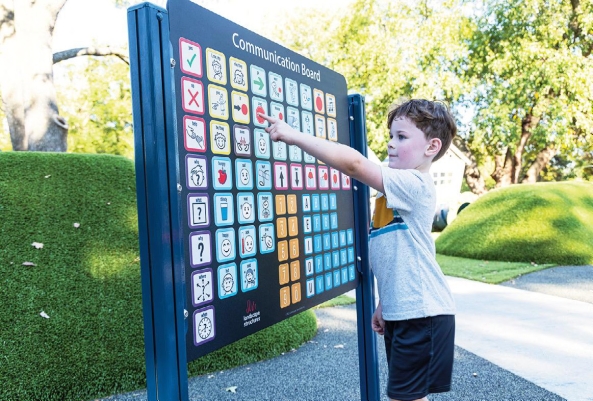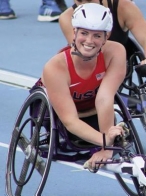
SOUND IDEA: Incorporating the Symbol Communication Sign allows individuals who are non-verbal or early learning to communicate with friends and caregivers.
symbols allow people to point to what they feel, or what they need or want, such as going down the slide or going to the bathroom. This can make playgrounds more inclusive to nonverbal people, and it can be a helpful tool for anyone trying to hear a soft voice on a noisy playground. These signs also can provide prompts for children who struggle to express themselves.
SPOTLIGHT: LINCOLN GLEN PARK
A recent retrofit of Lincoln Glen Park in San Jose highlights the wide variety of updates that can make a playground more inclusive. The park's retrofit specifically aimed to serve and engage those
who are on the autism spectrum, are medically fragile, and have sensory, cognitive, developmental, and physical disabilities.
The park's updates improved physical accessibility, with wheelchair-accessible slopes leading to play areas, as well as wide paths and ramps. The retrofit also introduced new sensory-engaging elements, as well as landscaping with stimulating colors, textures, and fragrances to help people of varying abilities navigate the space. And, the park introduced storytelling, with a theme highlighting the early history of the local area, Willow Glen, which served as a postal communications hub in the late 19th and early 20th centuries.
Once you begin to explore the possibilities of adaptive recreation, you will see how it benefits people of all abilities. Any playground – even older spaces with more dated equipment – can be retrofitted with upgrades and additions that make the space more inclusive and responsive to the needs of the community. By working together to create more opportunities for inclusive play, communities can enrich life and learning for all kids. •
ABOUT THE AUTHOR:

Jill Moore brings the voice of the disabled community and inclusive design practices into the product-development process at Landscape Structures. With a specific focus on merging lived experience with universal design principles, Jill promotes and educates audiences on the importance of integrating inclusion in play, and bringing people with disabilities into the conversation. As an accredited educational presenter — both in the classroom and the playground — play has become her full-time role. During her lifetime, Jill has represented Team USA as a multi-sport athlete, bringing perspective on the importance of recreation and how imperative equitable access to play is for all.
WORKING TOGETHER : MAKING PLAYGROUNDS MORE INCLUSIVE AND RESPONSIVE WITH UPGRADES AND ADDITIONS
What can you do to make a retrofit possible and create more opportunities for inclusive play at your local playground? Here are four key ways to get organized, as you make your case.
Start educating the community and bringing people together. People love their playgrounds, and when they become aware of the rich opportunities a more inclusive playground provides, they want that for their own kids and families! This includes families with people of all abilities.
Define what inclusion looks like for your family — and your community. What are your needs, and what are the needs of others who use your playground? What could be updated or added to your playground that would make it more inclusive? Find your local ability demographics. For example, what needs are being served in the community, care programs nearby, and local recreation or hospital groups? Doing some of the legwork in advance, makes it easier for those who manage the playground to understand both the challenge and the solution, as well as to prioritize the most immediate needs of the community.
Show up in person to make your voice heard and bring your friends. Attending and speaking with decision-makers at events, like community meetings or school board meetings, can make a big difference. It links the need for inclusivity with specific faces and personalities. The more people, the better — having a group show up reinforces the point that everyone benefits from more inclusive play spaces.
Identify and partner with like-minded nonprofits and community organizations. These groups may be able to help by providing financial support, finding grants and other funding sources, sharing your message more widely, or acting as an advocate for your cause. To get you started, in addition to any local groups unique to your community, consider local chapters of organizations, such as: the YMCA, PTA, Kiwanis International, Jaycees, Rotary International, or Lions Clubs. KABOOM! also is a great resource, as a national nonprofit dedicated to ending inequity in play spaces.